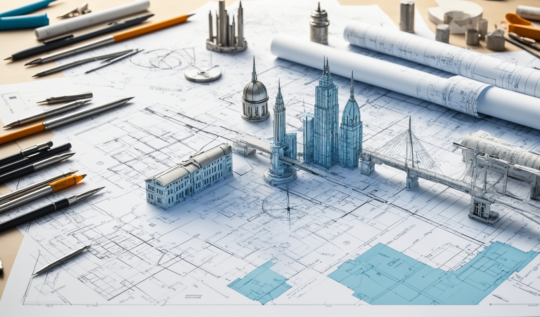Resilient Building Materials: Best Options for Flood, Fire, and Earthquake Resistance
In an unpredictable world, resilient building materials are essential for safeguarding our structures, whether they serve as places of worship, community centers, retail spaces, hotels, or restaurants. Selecting materials that can withstand natural disasters helps protect lives, preserves properties, and reduces repair costs over time. This article explores the best building materials for resilience against floods, fires, and earthquakes, along with site planning considerations that enhance durability and safety. At UNITE – Architecture & Beyond, we’re here to help clients make informed decisions about materials and construction methods that maximize resilience for their unique needs.
Key Principles of Building Resilience for Churches and Commercial Spaces
Resilience in building design means choosing materials and construction methods that can withstand environmental stress, minimize damage, and ensure long-term durability. However, building for resilience isn’t a one-size-fits-all approach. Different types of facilities—such as churches, hotels, and retail spaces—face unique challenges based on usage, location, and purpose.
At UNITE, we understand these complexities and help clients select resilient materials that balance safety, durability, and aesthetic goals. From waterproof flooring for flood-prone areas to tempered glass for fire protection, our team can recommend solutions tailored to each project’s specific goals.
Flood-Resistant Building Materials and Site Planning for Churches and Commercial Properties
Flooding is a significant concern for many facilities, especially those located in low-lying or coastal areas. Flood-resistant materials help prevent water damage, minimize mold growth, and make cleanup easier. Strategic site planning also plays a key role in flood resilience.
- Waterproof Concrete and Flood-Resistant Wall Panels: Waterproof concrete and fiberglass reinforced panels (FRPs) offer superior flood resistance. These materials prevent water absorption and resist mold, making them ideal for areas like church basements, hotel storage spaces, and retail back rooms.
- Elevated Flooring Systems: For buildings in flood-prone zones, raised flooring systems and concrete piers can help protect critical areas from water damage. These solutions are particularly useful for urban retail centers and hotels that may not have flexible site placement options.
Site Planning for Flood Resilience
- Drainage Solutions and Permeable Parking Lots: Permeable surfaces in parking areas allow rainwater to absorb into the ground, reducing runoff. This technique is beneficial for large parking areas in churches, hotels, and shopping centers.
- Green Spaces as Flood Buffers: Landscaping elements like rain gardens, retention ponds, and bioswales act as natural flood defenses. These green spaces help absorb water, reducing the strain on drainage systems.
Fire-Resistant Materials and Fire Safety Design for Churches and Commercial Spaces
Fires can cause devastating damage to structures, making fire-resistant materials crucial for both church and commercial facilities. Fire-safe site planning and clear emergency access routes add additional layers of safety.
- Exterior Cladding, Tempered Glass, and Fire-Retardant Roofing: Materials like fiber cement siding, tempered glass, and fire-rated roofing materials protect structures from external fire risks. These materials are widely used in hotels, retail spaces, and church campuses due to their durability and safety benefits.
Fire-Safe Site Planning
- Defensible Green Spaces and Hardscaping Fire Barriers: Hardscaping elements, such as stone pathways and concrete barriers, can act as firebreaks, especially around outdoor dining areas and entryways.
- Emergency Vehicle Access: Clear, well-designed access routes for fire trucks and emergency vehicles are essential for parking lots and main entrances in commercial properties and larger church campuses.
Earthquake-Resistant Materials and Structural Reinforcements for All Building Types
In earthquake-prone regions, materials and structural reinforcements that can absorb seismic energy are essential for safety. Churches, hotels, and retail spaces each have unique needs when it comes to seismic resilience, from open sanctuary spaces to multi-story retail structures.
- Reinforced Concrete, Steel Frameworks, and Flexible Wood Framing: Reinforced concrete and steel beams absorb seismic energy, reducing structural damage. Flexible wood framing can be particularly beneficial in smaller commercial spaces and lower-budget projects, providing flexibility and reducing collapse risk.
Site Planning for Earthquake Resilience
- Open Outdoor Spaces and Safe Utility Placement: Open spaces around churches and commercial facilities provide areas where people can gather safely during or after an earthquake.
- Parking Structure Reinforcement: For multi-level parking structures, seismic reinforcements are critical, especially in hotels and urban retail centers where parking structures are common.
Sustainable and Resilient Green Spaces for Both Church and Commercial Properties
Incorporating eco-friendly materials and resilient green spaces adds both beauty and functionality. These elements can enhance resilience against floods, winds, and other environmental factors.
- Eco-Friendly and Durable Materials: Sustainable materials like recycled steel, reclaimed wood, and low-emission concrete support both resilience and sustainability goals, making them ideal for churches and commercial facilities committed to environmentally responsible building practices.
- Natural Wind Barriers and Landscaping: Landscaping solutions, such as windbreaks and stormwater management systems, reduce exposure to high winds and provide visual appeal for hotels and church campuses alike.
Cost Considerations and Long-Term Benefits of Resilient Building Materials
While resilient building materials may come with a higher upfront cost, their long-term benefits often outweigh these initial expenses. From reduced maintenance needs to potential insurance discounts, investing in resilience brings value over time.
- Insurance and Incentives: Some insurers offer discounts for resilient materials, providing additional savings for both churches and commercial property owners.
- Tax Incentives and Grants: Churches and businesses pursuing eco-friendly goals may be eligible for tax incentives and grants that support resilient, sustainable materials.
Partner with UNITE for Resilient Building Design
Choosing resilient materials and smart site planning can make a significant difference in the longevity and safety of a facility. By integrating flood, fire, and earthquake-resistant materials, churches and commercial properties can protect their investments while ensuring a safe environment for visitors, employees, and congregants. At UNITE, we are dedicated to helping clients navigate the complexities of resilient building design. From product selection to construction methods and site planning, our team provides expertise at every step, ensuring that each project is equipped to face future challenges with confidence.
To learn more about resilient building materials and how we can help create safe, durable facilities, reach out to our team at UNITE – Architecture & Beyond. We look forward to helping you make your vision a reality.





